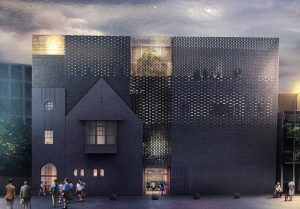With funding from Gandel Foundation, the Melbourne Holocaust Museum (MHM) is designing a permanent exhibition with award-winning Art Processors to engage young visitors with the lessons of the Holocaust. The exhibition explores experiences of children in hiding during the war who later migrated to Melbourne. The announcement of the funding for the children-focused exhibition coincides with the birthday of Anne Frank (12 June 1929), one of the children victims of the Holocaust whose book, The Diary of a Young Girl, continues to inspire to this day.
The MHM will launch the children-focused exhibition, first of its kind in Australia, in 2023 as part of their multi-million-dollar project to build a world-class museum. It will complement the MHM’s main permanent Holocaust exhibition by providing age-appropriate learning for younger visitors.
The exhibition has emerged through MHM and the Gandel Foundation’s longstanding partnership furthering Holocaust education in Australia. In 2013, the MHM hosted the acclaimed travelling exhibition, Anne Frank – A History for Today, (funded by Gandel Foundation). Seeing young visitors resonate with the exhibition’s themes, MHM then developed their award-winning education program, Hide & Seek, with multi-year funding from the Gandel Foundation in 2014.
The Hide and Seek program soon became key to the MHM’s offerings for students in levels 5-7. Its ongoing pedagogical impact inspired MHM and the Gandel Foundation to join forces again to create a dedicated space for younger audiences in the MHM’s new museum.
“The recent Gandel Holocaust Survey showed that one of the two most important ways in which the public learns about the Holocaust is visiting a museum (the other being specific Holocaust education in schools),” said Vedran Drakulic OAM, CEO of Gandel Foundation.
“It was critically important to offer this type of experience for young people, teaching them about the Holocaust through the eyes of their peers – Jewish children who were trying to survive, and who later settled in Melbourne.”
The exhibition explores the lives of seven survivors drawing from first-person narratives. It emphasises the survivors’ bravery and perseverance, alongside the acts of kindness by others that helped save their lives. The exhibition features survivors Joe de Haan, John Lamovie, Halina Zylberman, Paul Grinwald, Henri Korn, Sonia Kempler and Floris Kalman.
“At the museum, we know that sharing stories is the best way to connect to our shared humanity,” says Jayne Josem, MHM CEO & Museum Director. “For younger visitors to encounter stories of survivors, who were children like them during the war, but had incredible experiences of being in hiding and being rescued, what better way to learn about history and humanity, intolerance and kindness, justice and hope?”
The exhibition showcases primary source material from the MHM’s collections curated with a child’s perspective in mind, including testimonies, artefacts, photographs, and documents from the Holocaust. An item of significance includes Joe de Haan’s false identity card issued in 1941 (left). It identified him as delivery boy Willem Walvis with Joe’s photo and address. It was too dangerous for Joe to stay in his hometown, so he was hidden by the Resistance in the north of the Netherlands. Today, Joe volunteers at the MHM sharing his experience with students.
The innovative exhibition also comprises cutting-edge exhibition technologies, including soundscapes, moving image, projections, illustrations, and dioramas, to create an immersive learning journey. Building on a concept developed with Thylacine Design, MHM are working with Art Processors to bring the exhibition to life.
Art Processors’ interactive media and exhibition design services have supported arts and culture industry leaders, including the Art Gallery of New South Wales, Australian War Memorial, MONA, and significant overseas organisations, including the Getty and Portland Museum of Art.
This exhibition continues MHM’s leadership in Holocaust education, research, and remembrance. Alongside Hide and Seek, MHM’s education programs include In Touch with Memory for levels 8-12, virtual workshops and professional learning for teachers. MHM engages more than 20,000 students a year with an aim to reach 35,000 per annum by 2027.
The MHM will install the exhibition in their new museum building, alongside another permanent exhibition space, special exhibition gallery, VR facility, learning areas, contemplative garden, memorial room, resource centre and library and two auditoriums. With construction almost complete, the museum has begun plans for an early 2023 launch.

END

